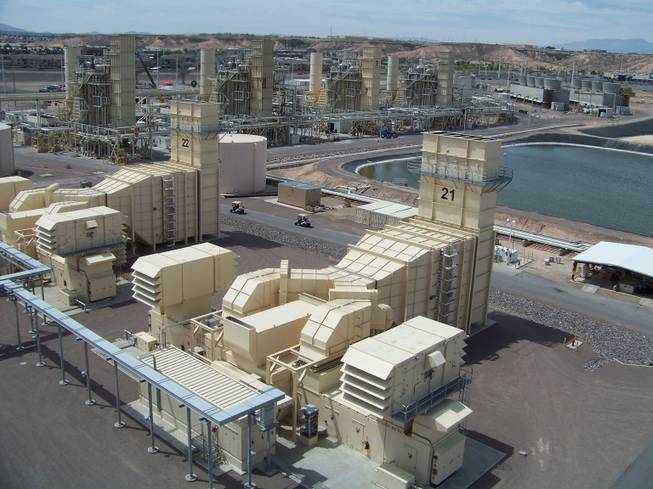
NV Energy
Peakers at the Clark Generating Station in Henderson were installed in 2009 at a cost of $400 million to help the plant deal with power fluctuations, ranging from heavy use in the summer to random weather conditions affecting solar- and wind-energy gathering. The 12 supplementary power stations at the plant can provide enough energy to power more than a third of a million homes.
Saturday, June 29, 2013 | 2 a.m.
Sun weather coverage
With weekend temperatures threatening to reach record-breaking numbers, it’s no surprise that NV Energy technicians have a plan to keep up with projected and equally record-breaking energy demands.
What’s interesting, however, is how they plan to do it.
Rather than buy extra power on the expensive energy market, NV Energy will rely on peaking units — supplementary power stations that, in less than 10 minutes after being fired up, can provide enough energy to power more than a third of a million homes, said Lloyd “Andy” Anderson, operations manager of NV Energy’s Edward W. Clark Generating Station.
And days like Saturday and Sunday are why the peakers were designed and installed, Anderson said.
“These are the days that these units were really were built for,” he said.
The peakers at the Clark Generating Station in Henderson were installed in 2009 at a cost of $400 million to help the plant deal with power fluctuations, ranging from heavy demand in the summer to random weather conditions affecting solar- and wind-energy gathering, Anderson said. The 12 units at the Henderson plant are the only ones in operation in Southern Nevada, said Mark Severts, project communications director.
And though the natural gas-run power units can be more expensive than the plant’s normal generators, use of the peakers allows NV Energy to immediately respond to energy fluctuations and to free the company from potentially high market prices, Anderson said.
“When we fill that gap with our own power, it allows the market to normalize more,” he said.
Responding that quickly to energy demands can save consumer costs from ballooning too high during the summer, Anderson said. Though it’s difficult to gauge how much money is saved due to constantly changing energy demands and market conditions, use of the peakers is estimated to cut costs by about half when compared with buying extra energy on the open market, he said.
“There is no question that during times like today and during such hot spells, these units are paying for themselves in a dramatic way by allowing us to avoid purchasing high-cost power during such expensive, high-energy-demand times,” Severts said.
The peaking units can produce up to a combined 600 megawatts of electricity at any given time — enough to power about 370,000 homes — in less than 10 minutes, Severts said. That estimation also takes into account high air conditioning use, which means the units could power up to 600,000 homes without heavy electrical usage, he said.
That capacity could prove useful this weekend, when NV Energy projects to use up to 6,000 megawatts at any given time in the Las Vegas Valley, about 200 megawatts more than the electricity demand record set in July of 2007, when temperatures hit 114 degrees here.
Last year, there were around 400 starts for any number of the plant’s 12 peaking units, with run times averaging about four hours, Anderson said.
The peaking units essentially run like a jet turbine engine, with additional equipment set up to recycle the exhaust produced by the engines into more energy, Severts said. The units replaced several older generators, installed in the 1950s, that produced about half the amount of energy with twice as many emissions, he said.
Calling the shots of when to run the peaking units is a team of four dispatchers, most with more than 30 years of experience, who work with other staff members to determine when and for how long the units will run.

Join the Discussion:
Check this out for a full explanation of our conversion to the LiveFyre commenting system and instructions on how to sign up for an account.
Full comments policy